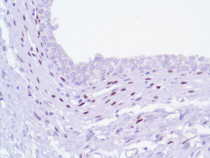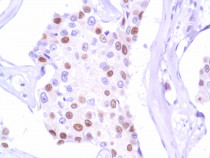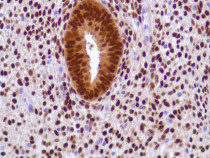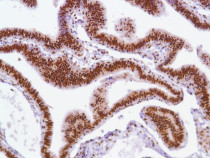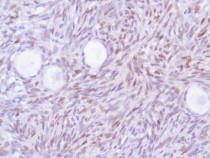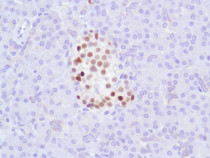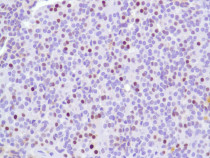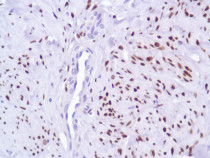ARG53495
anti-Progesterone Receptor antibody [SP42]
anti-Progesterone Receptor antibody [SP42] for IHC-Formalin-fixed paraffin-embedded sections and Human
Cancer antibody; Gene Regulation antibody; Neuroscience antibody; Signaling Transduction antibody
Overview
| Product Description | Rabbit Monoclonal antibody [SP42] recognizes Progesterone Receptor |
|---|---|
| Tested Reactivity | Hu |
| Tested Application | IHC-P |
| Host | Rabbit |
| Clonality | Monoclonal |
| Clone | SP42 |
| Isotype | IgG |
| Target Name | Progesterone Receptor |
| Antigen Species | Human |
| Immunogen | Recombinant protein encoding aa 412-526 of human progesterone receptor. |
| Conjugation | Un-conjugated |
| Alternate Names | PR; NR3C3; Nuclear receptor subfamily 3 group C member 3; Progesterone receptor |
Application Instructions
| Application Suggestion |
|
||||
|---|---|---|---|---|---|
| Application Note | IHC-P: Antigen Retrieval: Boil tissue section in 10mM citrate buffer, pH 6.0 for 10 min followed by cooling at RT for 20 min. Incubation Time: 30 min at RT. * The dilutions indicate recommended starting dilutions and the optimal dilutions or concentrations should be determined by the scientist. |
||||
| Positive Control | Breast Carcinoma |
Properties
| Form | Liquid |
|---|---|
| Buffer | Tissue culture supernatant in TBS (pH 7.5), 1% BSA and < 0.1% Sodium azide |
| Preservative | < 0.1% Sodium azide |
| Stabilizer | 1% BSA |
| Storage Instruction | For continuous use, store undiluted antibody at 2-8°C for up to a week. For long-term storage, aliquot and store at -20°C or below. Storage in frost free freezers is not recommended. Avoid repeated freeze/thaw cycles. Suggest spin the vial prior to opening. The antibody solution should be gently mixed before use. |
| Note | For laboratory research only, not for drug, diagnostic or other use. |
Bioinformation
| Database Links | |
|---|---|
| Gene Symbol | PGR |
| Gene Full Name | progesterone receptor |
| Background | This gene encodes a member of the steroid receptor superfamily. The encoded protein mediates the physiological effects of progesterone, which plays a central role in reproductive events associated with the establishment and maintenance of pregnancy. This gene uses two distinct promotors and translation start sites in the first exon to produce two isoforms, A and B. The two isoforms are identical except for the additional 165 amino acids found in the N-terminus of isoform B and mediate their own response genes and physiologic effects with little overlap. [provided by RefSeq, Jan 2011] |
| Function | The steroid hormones and their receptors are involved in the regulation of eukaryotic gene expression and affect cellular proliferation and differentiation in target tissues. Progesterone receptor isoform B (PRB) is involved activation of c-SRC/MAPK signaling on hormone stimulation. Isoform A: inactive in stimulating c-Src/MAPK signaling on hormone stimulation. Isoform 4: Increases mitochondrial membrane potential and cellular respiration upon stimulation by progesterone. [UniProt] |
| Cellular Localization | Nucleus |
| Research Area | Cancer antibody; Gene Regulation antibody; Neuroscience antibody; Signaling Transduction antibody |
| Calculated MW | 99 kDa |
| PTM | Phosphorylated on multiple serine sites. Several of these sites are hormone-dependent. Phosphorylation on Ser-294 occurs preferentially on isoform B, is highly hormone-dependent and modulates ubiquitination and sumoylation on Lys-388. Phosphorylation on Ser-102 and Ser-345 also requires induction by hormone. Basal phosphorylation on Ser-81, Ser-162, Ser-190 and Ser-400 is increased in response to progesterone and can be phosphorylated in vitro by the CDK2-A1 complex. Increased levels of phosphorylation on Ser-400 also in the presence of EGF, heregulin, IGF, PMA and FBS. Phosphorylation at this site by CDK2 is ligand-independent, and increases nuclear translocation and transcriptional activity. Phosphorylation at Ser-162 and Ser-294, but not at Ser-190, is impaired during the G(2)/M phase of the cell cycle. Phosphorylation on Ser-345 by ERK1/2 MAPK is required for interaction with SP1. Sumoylation is hormone-dependent and represses transcriptional activity. Sumoylation on all three sites is enhanced by PIAS3. Desumoylated by SENP1. Sumoylation on Lys-388, the main site of sumoylation, is repressed by ubiquitination on the same site, and modulated by phosphorylation at Ser-294. Ubiquitination is hormone-dependent and represses sumoylation on the same site. Promoted by MAPK-mediated phosphorylation on Ser-294. Palmitoylated by ZDHHC7 and ZDHHC21. Palmitoylation is required for plasma membrane targeting and for rapid intracellular signaling via ERK and AKT kinases and cAMP generation. |
Images (13) Click the Picture to Zoom In
-
ARG53495 anti-Progesterone Receptor antibody [SP42] IHC-P image
Immunohistochemistry: Human Bladder stained with ARG53495 anti-Progesterone Receptor antibody [SP42].
-
ARG53495 anti-Progesterone Receptor antibody [SP42] IHC-P image
Immunohistochemistry: Human Breast Carcinoma stained with ARG53495 anti-Progesterone Receptor antibody [SP42].
-
ARG53495 anti-Progesterone Receptor antibody [SP42] IHC-P image
Immunohistochemistry: Human Breast stained with ARG53495 anti-Progesterone Receptor antibody [SP42].
-
ARG53495 anti-Progesterone Receptor antibody [SP42] IHC-P image
Immunohistochemistry: Human Cervical SCC stained with ARG53495 anti-Progesterone Receptor antibody [SP42].
-
ARG53495 anti-Progesterone Receptor antibody [SP42] IHC-P image
Immunohistochemistry: Human Cervix stained with ARG53495 anti-Progesterone Receptor antibody [SP42].
-
ARG53495 anti-Progesterone Receptor antibody [SP42] IHC-P image
Immunohistochemistry: Human Endometrium stained with ARG53495 anti-Progesterone Receptor antibody [SP42].
-
ARG53495 anti-Progesterone Receptor antibody [SP42] IHC-P image
Immunohistochemistry: Human Fallopian Tube stained with ARG53495 anti-Progesterone Receptor antibody [SP42].
-
ARG53495 anti-Progesterone Receptor antibody [SP42] IHC-P image
Immunohistochemistry: Human Ovarian Adenocarcinoma stained with ARG53495 anti-Progesterone Receptor antibody [SP42].
-
ARG53495 anti-Progesterone Receptor antibody [SP42] IHC-P image
Immunohistochemistry: Human Ovary stained with ARG53495 anti-Progesterone Receptor antibody [SP42].
-
ARG53495 anti-Progesterone Receptor antibody [SP42] IHC-P image
Immunohistochemistry: Human Pancreas stained with ARG53495 anti-Progesterone Receptor antibody [SP42].
-
ARG53495 anti-Progesterone Receptor antibody [SP42] IHC-P image
Immunohistochemistry: Human Parathyroid Adenoma stained with ARG53495 anti-Progesterone Receptor antibody [SP42].
-
ARG53495 anti-Progesterone Receptor antibody [SP42] IHC-P image
Immunohistochemistry: Human Prostate stained with ARG53495 anti-Progesterone Receptor antibody [SP42].
-
ARG53495 anti-Progesterone Receptor antibody [SP42] IHC-P image
Immunohistochemistry: Human Uterus stained with ARG53495 anti-Progesterone Receptor antibody [SP42].
